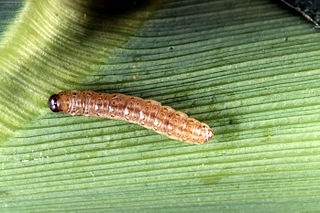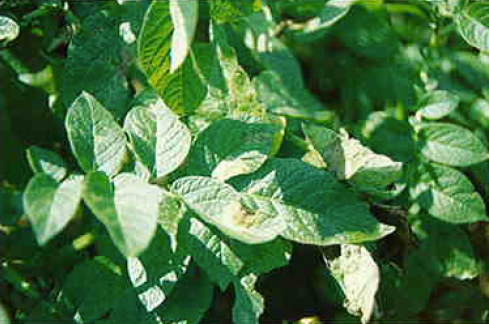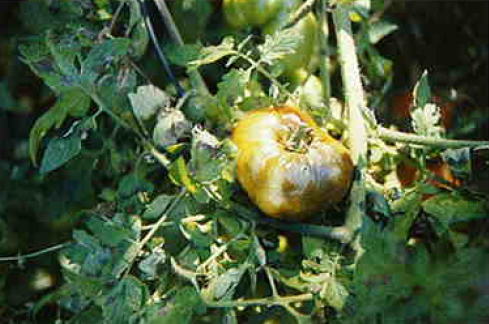Pest and Disease Report 9/27/19

Possible pests
Hickory Tussock Moth (Lophocampa caryae) – Because of their bizarre appearance and local abundance in some areas, hickory tussock moth caterpillars are also hard to miss this time of year. Large by late August, these caterpillars are constantly on the move and like browntail moth caterpillars, seem to have an affinity for houses and decks. You might also notice the silken strands they use to rappel from trees to the ground, which are quite thick for caterpillar standards and almost look like dangling fishing line in the right lighting.
While not as severe as those of the notorious browntail moth caterpillars, the dense hairs on hickory tussock moth caterpillars serve as a defensive mechanism as well. As a reminder, these can cause skin irritation to sensitive individuals and hair-bearing caterpillars should not be handled.
European Corn Borer
Identification:
ECB moths are about ¾ inches long, light brown in color with lighter bands on the wings. Eggs are white and are laid in flat masses on undersides of leaves. Larvae are light colored, with a pattern of small dark spots on each segment. The head capsule is flattened and black or dark brown. The dark head capsule distinguishes ECB larvae from pepper maggot larvae, another pepper pest, which are completely white. Newly hatched larvae are 1/8 inch long and full-grown larvae are ¾ -1 inch long.
In pepper, it may be difficult to identify an ECB infestation without destructively monitoring fruit. When ECB larvae are entering pepper fruit, they leave a pile of light brown frass on the fruit surface, which is the only sign of infestation until, in some cases, 2-3 weeks later, bacterial soft rot may cause fruit decay.
Asian Crazy Worm – No, this is not a joke
Crazy worms are a type of earthworm native to East Asia. They are smaller than nightcrawlers, reproduce rapidly, are much more active, and have a more voracious appetite. This rapid life cycle and ability to reproduce asexually gives them a competitive edge over native organisms, and even over nightcrawlers. When disturbed, crazy worms jump and thrash about, behaving like a threatened snake.
Please see this fact sheet for more information and to learn how to identify this pest:Asian Crazy Worm
Fall Webworm
Fall Webworm (Hyphantria cunea) – With large sprawling nests made of silken webbing, fall webworm is hard to miss and can often appear to have engulfed an entire tree. Much of the confusion between fall webworm and browntail moth arises due to the small size of the nests early on and that fact that both insects can be found on some of the same tree species. As with many other aspects of forest entomology, timing and patience are key. August and September are the prime months for fall webworm caterpillar activity.
If you observe a small nest of webbing during this time and have doubts as to which insect it belongs to, give it a week. If the size of the nest increases by magnitudes, chances are you have fall webworm. Additionally, the size of fall webworm nests should already be quite substantial by the time the small, tightly-woven winter nests of browntail moth caterpillars begin to appear later in the season.
Fall Home-Invading Insects: Various insects, such as ladybugs, boxelder bugs, seedbugs, and stink bugs will begin to seek overwintering shelters in warm places, such as homes, throughout the next couple of months. While such invaders do not cause any measurable structural damage, they can become a nuisance especially when they are present in large numbers. While the invasion has not yet begun, if you are not willing to share your home with such insects, now should be the time to repair torn window screens, repair gaps around windows and doors, and sure up any other gaps through which they might enter the home.
Possible Diseases
Late blight(Potato and Tomato)
Late Blight Information for Every Gardener in Maine


Potato and Tomato Late Blight:
- is a community disease, as an infected garden can spread spores and affect commercial potato fields miles away.
- can cause severe losses in commercial potato production.
- has forced commercial potato growers out of farming. This closes a business, stresses rural families and the local economy.
Before planting, home gardeners can:
- Use healthy tomato transplants and certified seed potatoes, NOT potatoes from a grocery store.
- Discard potato seed that has sunken blemishes on the surface with rusty, granular discoloration in the flesh underneath.
After planting, home gardeners can:
- Allow sufficient space between plants to allow the tops of the plants to remain dry.
- Protect the growing potato and tomato plants with products containing mancozeb, maneb or chlorothalonil. These are available at garden centers and should be applied at seven-day intervals or as directed on the label. Local potato growers can also provide advice on spray timing.
- Check the plants regularly for disease. If symptoms appear, pull the diseased plant and place in a plastic bag. Discard the bag without opening it. DO NOT place the diseased plant into a compost pile or leave it in the garden. Both tomato fruit and potato tubers are quickly broken down when late blight attacks them. Noninfected potato tubers or tomato fruits, even if the plant is diseased, are usable.
- Check the harvested tomato fruit and potato tubers regularly as the disease can progress quickly. Discard infected fruit, plants or tubers in a sealed plastic bag.
Bacterial wilt (Cucumbers) Bacterial wilt signs and symptoms
Bacterial wilt occurs primarily on cucumbers and melons, but may also occur on squash and pumpkins. The disease is caused by the bacterium Erwinia tracheiphila.
Disease cycle of bacterial wilt
The disease is caused by the bacterium Erwinia tracheiphila and is closely associated with cucumber beetles. The bacteria overwinter in cucumber beetles. Two species, striped, and spotted cucumber beetles, carry the bacterium from plant to plant, and infection often happens through beetle feeding wounds. The beetles transmit the disease when they feed on young leaves in the spring. Once inside the plant, the bacteria multiply and spread rapidly. The disease is moved from plant to plant by beetles. The disease is usually first seen on the edges of plantings, where the beetles first land.
Control
Control of the disease is dependent upon control of the cucumber beetle. There are also varieties available with bacterial wilt resistance. Keep in mind that other disease, insect, pesticide, or environmental factors can cause wilting of leaves and death of vines.
Scab (potatoes);Photo Potato common scab
Potato scab is a common tuber disease that occurs throughout the potato growing regions of the world. Individual scab lesions are circular but may coalesce into large scabby areas. Insects may be involved in creating deep pitted lesions. The term “common scab” generally refers to the response of the disease to soil pH. Common scab is controlled or greatly suppressed at soil pH levels of 5.2 or lower. Common scab is widespread and is caused by S. scabies.
Recommended Disease-control Strategies
1. Use resistant varieties in fields where scab is a problem
3. Rotate heavily infested fields away from potatoes and alternate hosts such as radish, beets, and carrots. Use small grains, corn, or alfalfa in rotations; avoid red clover.
4. Maintain soil pH levels between 5.0 and 5.2 by using acid-producing fertilizers such as ammonium sulphate. Avoid or limit the use of such alkaline-producing amendments as lime and manure.
5. Avoid moisture stress during the 2 to 6 weeks following tuberization.
Cornell potato scab fact sheet
Diseases still possible
Powdery mildew (summer squash and pumpkins);Photos – powdery mildew
Introduction
Powdery mildew of cucurbits is caused by either of two fungi. Sphaerotheca fuliginea (less common) is known to infect about 60 plant genera and Erysiphe cichoracearum is known to infect about 160 plant genera. All cucurbits are susceptible to powdery mildew although it does not commonly attack watermelon. Yield losses of up to 50% have been reported and are the result of defoliation caused by the fungi.
Environmental Conditions
Unlike most fungi, the spores of powdery mildew do not require free water for germination and are actually inhibited in its presence. High humidity is beneficial but not necessary for spore germination. Infection has been known to occur below a relative humidity of 50%, although the humidity at the surface of the leaf is undoubtedly higher. High humidity also increases the rate at which the fungus grows after infection occurs. Spores will germinate above 50°F with an optimum of around 80°F and an upper limit of 90°F.
Symptoms
The initial signs of the fungus show on the upper or lower surface of (especially) shaded leaves. The infection may appear first as a pale yellow spots but the fungus soon sporulates yielding a characteristic powdery-white appearance (brown in the case of Sphaerotheca). This powdery appearance can involve the entire leaf which eventually turns yellow then brown and dries to the point that it crumbles when crushed.
